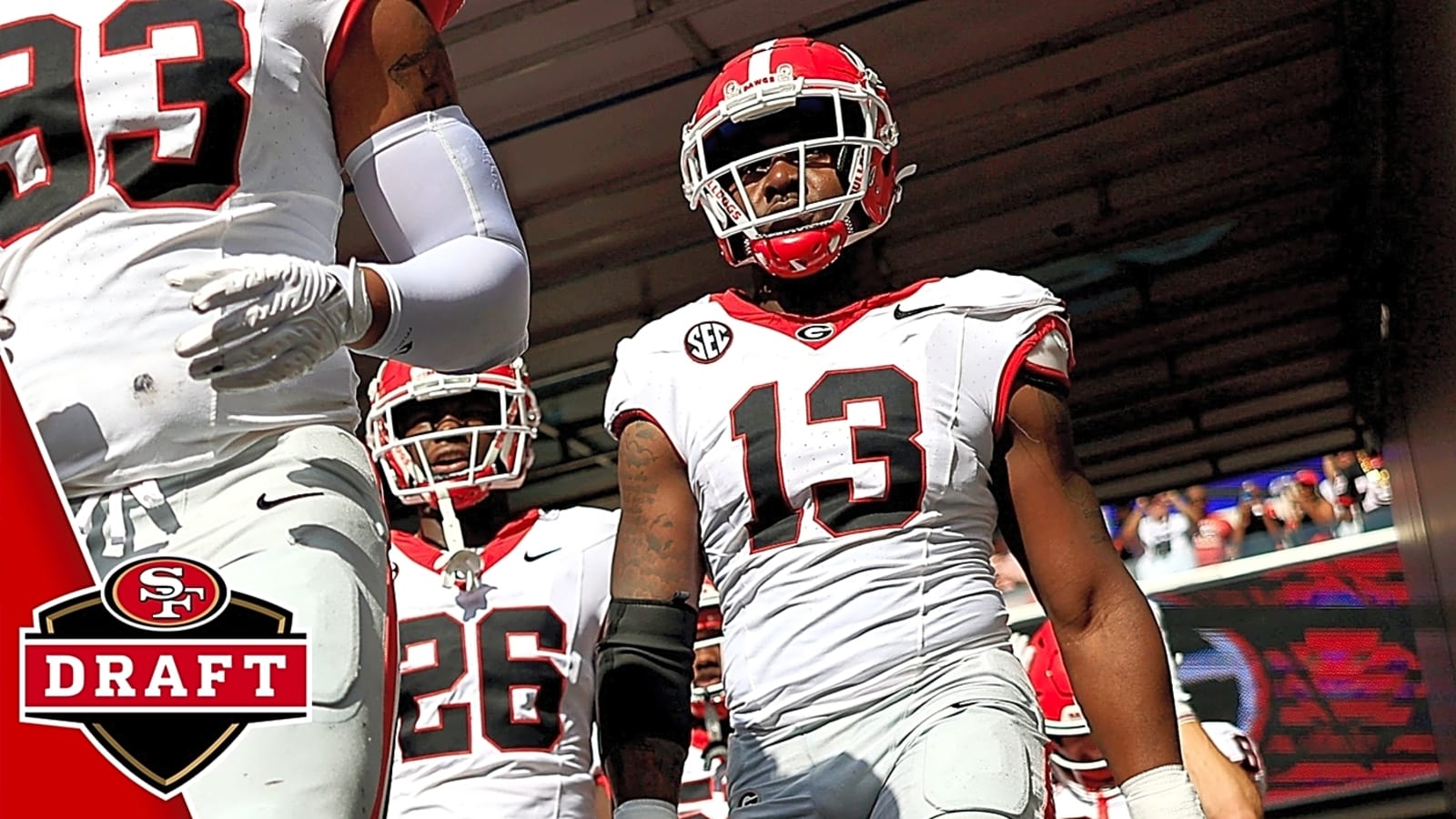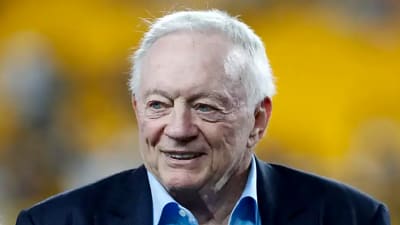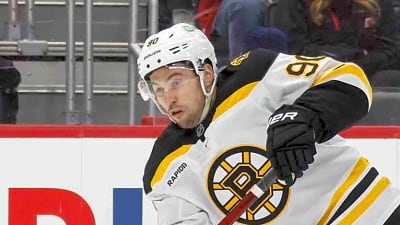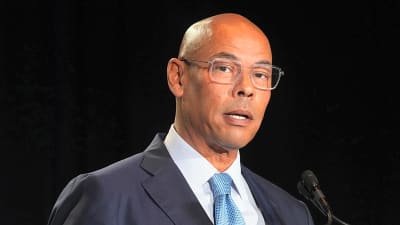
The 2025 NFL Draft is officially in the books, and if there was any doubt about what the San Francisco 49ers' priorities were, their selections made it loud and clear. Defense, defense, defense—with just a splash of future offensive firepower.
After an offseason full of tough roster decisions and high-profile departures, John Lynch and Kyle Shanahan approached this draft with a laser focus: reload the trenches, strengthen the spine of the defense, and invest in players who fit the 49ers' tough, physical brand of football.
While the team didn't chase headline-grabbing moves, they stuck to their identity, finding value, upside, and system fits across the board. From potential day-one impact defenders to late-round offensive projects, the 49ers' 2025 draft class is all about building the next wave of stars without sacrificing the team's ability to win now.
Let's dive into the biggest takeaways from the class, the players poised to make an impact, and the moves that raised eyebrows.
Strategy Focus: Defense, Defense, Defense, and Stop the Run
The 49ers made their intentions crystal clear in the 2025 NFL Draft: rebuild and reload a defense that took heavy hits this offseason.
There's no way to sugarcoat it—San Francisco's defensive core was gutted, losing key contributors like Dre Greenlaw, Talanoa Hufanga, Javon Hargrave, Leonard Floyd, and Maliek Collins, among others.
The urgency was real. The 49ers, once dominant against the run, slipped to 18th in rushing yards allowed per game in 2024 (124.6), a steep drop from fifth overall just a year earlier (98.7). Clearly, reinforcements weren't just a luxury—they were a necessity.
Let's take a closer look at how this year's draft class was designed to fill those gaps and restore the defense's identity.
1. Mykel Williams (EDGE, Georgia)
Goal: Compete with Yetur Gross-Matos for the starting spot opposite Nick Bosa
Impact: Williams is ready to be an instant contributor at the edge position. He has all the tools to be the next premier pass-rusher across from Bosa. His blend of power, bend, and quickness is rare at his size. The 49ers desperately needed a young, cost-controlled edge after missing Dee Ford's explosiveness the past few years. Williams can rotate early and eventually become a three-down starter, lessening the load on Bosa and keeping the pressure relentless off the edges.
Defensive line coach Kris Kocurek praised Williams as the best edge setter in college football, a trait that should significantly help improve the run defense.
2. Alfred Collins (DT, Texas)
Goal: Become a run-stuffing, disrupting fixture in the middle.
Impact: Collins offers new blood at defensive tackle, where the 49ers badly needed interior push. He brings incredible physical tools—explosiveness off the snap, great hand usage, and the ability to collapse the pocket from the inside. He will likely rotate early, but expect Collins to carve out a starter's share of snaps by midseason.
While with the Longhorns, Collins played in the 1-technique and 3-technique positions. He primarily lined up at the 3-technique, which suits the 49ers' alignment up front well. His addition keeps the defensive line rotation deep and dynamic, a signature piece of the 49ers' defensive identity.
3. Nick Martin (LB, Oklahoma State)
Goal: Replace Dre Greenlaw's production.
Impact: Martin brings linebacker depth and future starting potential. His instincts, sideline-to-sideline speed, and ability to cover backs and tight ends make him a natural fit to step into Greenlaw's old role. Although no rookie will immediately match Greenlaw's fire, Martin fits the aggressive, downhill attacking style the 49ers demand from their linebackers. Learning next to Fred Warner is the perfect developmental opportunity—and Martin could emerge as a major contributor quicker than people expect.
4. Upton Stout (CB, Western Kentucky)
Goal: Possible nickelback, allowing Deommodore Lenoir and Renardo Green to stay outside.
Impact: Stout could become a sneaky good addition at corner, with his sticky coverage skills. The 49ers' secondary saw depth issues last year, and Stout is a sticky, aggressive corner player who plays bigger than his size suggests, which could help. He projects as a rotational player early, with a chance to earn nickel or dime snaps by midseason. His ball skills and closing speed could be precisely what the defense needs against the speedier receivers in the NFC West. But it is also his usage against the run and rushing the passer that makes him an intriguing prospect.
5. Marques Sigle (S, Kansas State)
Goal: Become a rotational depth piece and possible starter if injuries hit.
Impact: Safety depth was a quiet but critical need for the 49ers, especially with Malik Mustapha still recovering from injury and Talanoa Hufanga no longer on the roster. Marques Sigle strengthens the back end, bringing smart, physical play and the versatility to line up both deep and in the box.
Expect Sigle to make an immediate impact on special teams while developing into a strong rotational player. With questions about availability early in the season, he could quickly find himself in the mix for meaningful defensive snaps—and may ultimately be groomed as a future starter.
In Summary
The 49ers didn't just draft defensive players, they drafted specific answers to the problems the offseason created:
- Pass rush needed young explosiveness → Williams
- Interior disruption needed new blood → Collins
- Linebacker toughness and coverage ability needed reloading → Martin
- Cornerback and safety depth had thinned → Stout and Sigle
Rather than panic or overpay for aging free agents, the 49ers invested in players who fit their system, timelines, and culture. This draft class may not replace the departed veterans immediately 1-for-1—but it gives San Francisco a strong, fast, and hungry group ready to evolve into the next great 49ers defense.
If even a few of these picks hit early, the defense might not skip as many beats as fans feared after free agency.
How It Fits Lynch and Shanahan's Long-Term Vision
The Niners didn't just reload the roster—they stayed true to the blueprint that has made them contenders year after year. If you've been following the John Lynch and Kyle Shanahan era, you know this draft strategy feels right on brand.
From the very beginning, they've believed the heart of a championship team is built up front—stacking monsters on the defensive line, staying physical, and believing a strong front makes life easier for every other unit.
This draft wasn't just about patching holes left by free agency, it was about future-proofing the defense. Instead of throwing money at aging veterans or making flashy moves, Lynch and Shanahan stayed patient, trusted their board, and added tough, athletic playmakers who fit the 49ers' identity: fast, physical, and fearless.
It's the same blueprint that got them to multiple NFC Championship Games and a Super Bowl run—and it's why the 49ers are set up to keep swinging at titles for years to come. This draft class isn't just about 2025. It's about keeping the window wide open deep into the future.
No Early Help for the Offensive Line: A Bold Gamble by Lynch and Shanahan
Let's be real: many fans expected the 49ers to grab serious offensive line help early in this draft. It felt like a no-brainer after seeing Brock Purdy scramble for his life at times last year—and knowing the team's Super Bowl hopes rest on keeping him upright.
Instead? Crickets until the seventh round.
The reason? It's simple but not exactly comforting: the 49ers believe in their guys. Lynch and Shanahan are betting that internal development will fix the cracks—not new blood. Players like Spencer Burford, Ben Bartch, Colton McKivitz, and Jake Brendel are expected to take significant steps forward. Meanwhile, the team trusts their scheme to mask protection weaknesses like it did in the past.
Drafting Connor Colby late was a quiet acknowledgment that depth is still needed, but it's clear the front office didn't see an O-lineman worth grabbing early who fit their value board.
It's a bold gamble—and it could pay off. But if the offensive line struggles out of the gate again in 2025, this draft strategy is one the Faithful might not soon forget.
The 49ers chose belief over reinforcements. Time will tell if it's brilliance—or a bet they'll wish they hadn't made.
Quarterback Room: Kurtis Rourke – A Worthwhile Gamble?
The 49ers took a flyer on Indiana's Kurtis Rourke in the seventh round. Once seen as a high-upside prospect, Rourke suffered an ACL tear last season, clouding his draft stock.
At full health, Rourke has the tools you want in a developmental QB: a strong arm, good size, and decent mobility. The 49ers are already set with Brock Purdy as the starter, but Rourke offers a no-pressure project who can sit, rehab, and learn.
Was it a good pick?
For a seventh-rounder, absolutely. Low risk, high reward. He can start the season on the physically unable to perform (PUP) list. While on the PUP list, he won't be able to practice but will still participate in team meetings, game prep, and utilize team facilities.
If he doesn't pan out, no harm, no foul. But if he regains pre-injury form, the Niners could have found themselves a future backup—or even a trade chip.
Final Thoughts
It wasn't headline-grabbing. It wasn't flashy. But it might just be championship-winning.
The 49ers didn't make blockbuster trades. They didn't chase splashy moves. But they did something maybe even more important: they stuck to a smart, focused plan.
They fortified a defense starving for young, hungry talent. They added smart depth across the board and took calculated swings without mortgaging their future.
It's a solid B+ draft on paper—addressing urgent needs, adding future building blocks, and taking calculated swings that could pay major dividends.
What do you think, Faithful? Who's your favorite pick? Which one has you worried? Drop your takes below—we're just getting started with this new era.
More must-reads:
- Browns rookie running back Quinshon Judkins arrested
- Patriots owner Robert Kraft offers rare praise for former HC Bill Belichick
- The 'Total touchdown leaders by NFL season since 2000' quiz
Breaking News
Trending News
Customize Your Newsletter
 +
+
Get the latest news and rumors, customized to your favorite sports and teams. Emailed daily. Always free!








